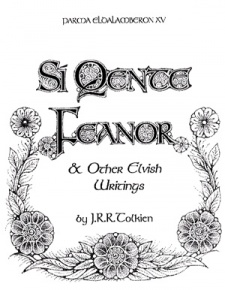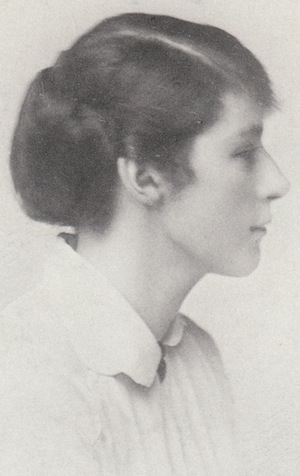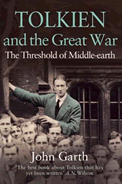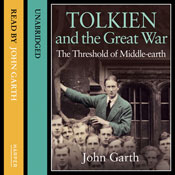John Garth
Sí Qente Feanor & Other Elvish Writings
J.R.R. Tolkien
(Parma Eldalamberon 15, 2004)
 The first phase in the history of J.R.R. Tolkien’s invented languages, roughly covering the decade from 1915, has been recounted in Parma Eldalamberon issues 11 to 14, which focused alternately on the ‘high elven’ Qenya and its sibling, Gnomish or Noldorin. Along the way two early writing systems, Rúmilian and Valmaric, have been introduced. This fifth instalment, comprising miscellaneous dainties from across the period, is what hobbits might call ‘filling up the corners’.
The first phase in the history of J.R.R. Tolkien’s invented languages, roughly covering the decade from 1915, has been recounted in Parma Eldalamberon issues 11 to 14, which focused alternately on the ‘high elven’ Qenya and its sibling, Gnomish or Noldorin. Along the way two early writing systems, Rúmilian and Valmaric, have been introduced. This fifth instalment, comprising miscellaneous dainties from across the period, is what hobbits might call ‘filling up the corners’.
As such, it uncovers no substantial new strata in the development of Tolkien’s grammatical, phonological, semantic or graphical concepts. However, it offers much new detail for linguists, and for the rest of us it contains valuable illustrations of Tolkien’s creative method and themes.
The collection takes its title from the centrepiece, ‘Sí Qente Feanor’, or ‘Thus spoke Fëanor’: a c.1917 Qenya text of the most substantial pieces of Elvish yet published, preceded only by the 1915–16 poem ‘Narqelion’. If Christopher Gilson’s painstaking and tentative translation is correct, this anticipates Tolkien’s explorations of human corruptibility in late writings associated with the ‘Athrabeth Finrod ah Andreth’. The topic also matches an early explicit religiosity seen, for example, in the myths of judgement after death in The Book of Lost Tales.
 Tolkien's muse: Edith Tolkien in 1916, when they married and she moved to Great Haywood to be near his army camp. Both her name and the Trent which flows through the village have their Elvish equivalents
Tolkien's muse: Edith Tolkien in 1916, when they married and she moved to Great Haywood to be near his army camp. Both her name and the Trent which flows through the village have their Elvish equivalentsIt seems particularly apt against the backdrop of the First World War, in which Tolkien had seen battle in 1916 before being invalided with trench fever. A notebook jotting naming ‘the root of disease’, Nerqal, ‘wherewith Melko [the Elves’ enemy] poisons his foes so that they die of a slow disease’, might have been suggested by time spent in hospital wards among gassed soldiers. The title of a sheaf of miscellaneous notes, ‘Enʒlaʒesíþ’ – Old English for ‘a warrior of the Angles’ – suggests a characteristic Tolkienian urge to use the distant past as a frame of reference: in this instance to define his own role as a soldier in an army that others tended to call ‘British’.
Tolkien’s early habit of writing his family into his myths is further evidenced: the wife of Ælfwine, the mariner who hears the Lost Tales, is Earisse, equated with Edith, his wife's name, of which it is a near-rendering into Qenya sounds. Geographical identifications draw life and art even closer. In the manuscript of ‘The Cottage of Lost Play’, we learn, a note identifies the river Sirion as the Trent or the Severn: the great rivers of Staffordshire and Worcestershire, respectively, in whose watershed lay Birmingham, Tolkien’s boyhood home. The Trent flows through Great Haywood (Tavrobel of the Lonely Isle), where Edith Tolkien wrote out the tale for her husband early in 1917.
Such embryonic ideas have no relation to later Middle-earth topography. But a further early identification of the Lost Tales’ great river Sirion with the Rhine evokes the defining idea of the Tales – that these are stories of which the European myths and fairy-tales are merely the fragmentary and faded echoes.
| “The notes afford the clearest illustration yet of how Tolkien ‘reconstructed’ what Shippey has called the asterisk-reality of his Lost Tales” |
Most intriguingly, in notes that relate names in the Lost Tales to equivalents in Germanic languages, we perhaps witness the first appearances of the names Beren and Lúthien, each with an application entirely different from the later, famous ones. Tolkien places a figure named Beren in an Indo-European-style myth of warring brothers; in a further noteworthy illustration of Tolkien’s recurrent interest in bears, his name is identified with Old English Beorn; the other brother is named in Old English Éoh, ‘horse’. Lúthien is not an Elvish enchantress but one of Ælfwine’s two sons. Curiously, the unwritten history behind the adaptations (not translations) is of the Elves meeting Germanic speakers and mimicking the sounds of their words, rather than of Indo-Europeans borrowing words from the Elves.
The notes headed ‘Enʒlaʒesíþ’ afford the clearest illustration yet of how Tolkien ‘reconstructed’ what Tom Shippey has called the ‘asterisk-reality’ of his Lost Tales. Here he gathered miscellaneous Old English word lore; then he proceeded to extrapolate. Finding that Watling Street, the Roman road from Dover to Chester, shared its name with the Milky Way, he devised a myth of terrestrial and celestial road-building that would explain this, involving race rivalry, treachery, and redress by the gods. References to the ‘Gnomes of Péac’ (the Derbyshire Peak, not a reference to height but a cognate of Puck), ‘the wild orcs of Íwerin’ (Ireland), and most of all ‘Wóden (Manweg)’ demonstrate that we are not only in the British Isles but also, already, in Middle-earth. Some items reflect Tolkien’s labour in the Ws on the Oxford English Dictionary, and the celestial Watling Street appears in his 1923 survey of philology for The Year’s Work in English Studies: professional work and private passion characteristically overlapping.
 These are early ideas, barely surviving in The Book of Lost Tales; yet now we see what must surely be the very first, barely recognisable conception of Fëanor as he was forged by Tolkien (as Eärendil sprang partly out of references to the obscure Wade) from a key figure in northern myth. He equates Fëanor to the smith Wéland, or Völundr, who takes cruel revenge in the Norse Völundarkviða for being forced to work in thralldom; Tolkien’s barely sketched version of his story makes Melko or an orc-king his captor, and thus exonerates the vengeful Wéland of barbarism.
These are early ideas, barely surviving in The Book of Lost Tales; yet now we see what must surely be the very first, barely recognisable conception of Fëanor as he was forged by Tolkien (as Eärendil sprang partly out of references to the obscure Wade) from a key figure in northern myth. He equates Fëanor to the smith Wéland, or Völundr, who takes cruel revenge in the Norse Völundarkviða for being forced to work in thralldom; Tolkien’s barely sketched version of his story makes Melko or an orc-king his captor, and thus exonerates the vengeful Wéland of barbarism.
The name-list to ‘The Fall of Gondolin’, quoted extensively in The Book of Lost Tales, Part Two, is published in full for the first time here, along with a similar list for ‘The Lay of the Children of Húrin’. Anyone studying textual relations or the development of nomenclature in The History of Middle-earth should not overlook Parma Eldalamberon. An ‘English-Qenya Dictionary’ is also of interest as an exercise in pseudo-history, with definitions written in the Valmaric script and some directions for usage, as if for the use of a traveller in Faërie.
All Tolkien’s surviving early runic work is presented, including Old English runes similar to those used in The Hobbit, and a flowing handwritten variant anticipating the written form of the cirth in The Treason of Isengard. Each character in an ephemeral ‘Gnomic’ script appears in angular and rounded forms, perhaps indicating an imagined chronological development from carved to handwritten. The later connection in the tengwar and cirth between shape and sound already exists in the early ‘Gondolinic Runes’, republished here from Mythlore 67 (Summer 1992) where they were presented and analysed by Paul Nolan Hyde, but now with an additional script version.
| “Language creation, for Tolkien, was an act of gorgeous, individualistic rebellion in an era of barbarous conformity” |
Some of the dainties laid out here take a good deal of chewing over. I remember encountering in the Bodleian Library the original manuscript, if such it can be called, for the material that comprises the most intractable chapter. In front of me were slips for an Anglo-Saxon dictionary that Tolkien had once begun, written on the back of torn-up Elvish grammar charts. The fragmented charts contained no complete paradigms and no labels – though it was possible to recognize sets of pronouns and case endings. Somehow, Mr. Gilson has now descried the currents in an apparent maelstrom, and exhaustively analysed these early Qenya fragments. Perhaps, indeed, he has said the last word on them in terms of their grammatical features; but it will no doubt help elucidate obscurities elsewhere in the corpus. Over and over again, the editors succeed in revealing the patterns of revision beneath an apparent maze of variants.
To appreciate Tolkien’s creative feelings when he worked on these paradigms one has only to recall his reminiscence of a sitting in a wartime lecture next to a soldier who suddenly exclaimed, ‘Yes, I think I shall express the accusative case by a prefix!’
Just consider the splendour of the words! . . . What a pondering of alternatives within one’s choice before the final decision in favour of the daring and unusual prefix, so personal, so attractive; the final solution of some element in a design that had hitherto proved refractory. Here were no base considerations of the ‘practical’, the easiest for the ‘modern mind’, or for the million – only a question of taste, a satisfaction of a personal pleasure, a private sense of fitness. As he said his words the little man’s smile was full of a great delight, as of a poet or painter seeing suddenly the solution of a hitherto clumsy passage.
(‘A Secret Vice’, The Monsters and the Critics and other essays, edited by Christopher Tolkien [London: George Allen & Unwin, 1983] p. 199)
Language creation, for Tolkien, was an act of gorgeous, individualistic rebellion in an era of barbarous conformity. These papers afford a glimpse over his shoulder as he worried at the details in the still of the night, repeatedly tearing up his work but, no doubt, also occasionally leaning back with a smile of delighted discovery. It was on such foundations that Tolkien constructed his cathedral of myth.
• Read my review of Parma Eldalamberon issues 12 and 13.
• Sí Qente Feanor & Other Elvish Writings is edited by Arden R. Smith, Christopher Gilson, Patrick H. Wynne and Bill Welden. It contains Names and Required Alterations (ed. Wynne); Name-list to ‘The Fall of Gondolin’ (ed. Gilson and Wynne); Sí Qente Feanor and Early Qenya Pronouns (ed. Gilson); Index of Names for ‘The Lay of the Children of Húrin’ (ed. Welden and Gilson); English–Qenya Dictionary (ed. Smith and Gilson); Addendum to ‘The Alphabet of Rúmil’ and ‘The Valmaric Script’ and Early Runic Documents (ed. Smith). Parma Eldalamberon 15 is currently out of print.
© John Garth 2006. Reproduced with thanks to West Virginia University Press.

